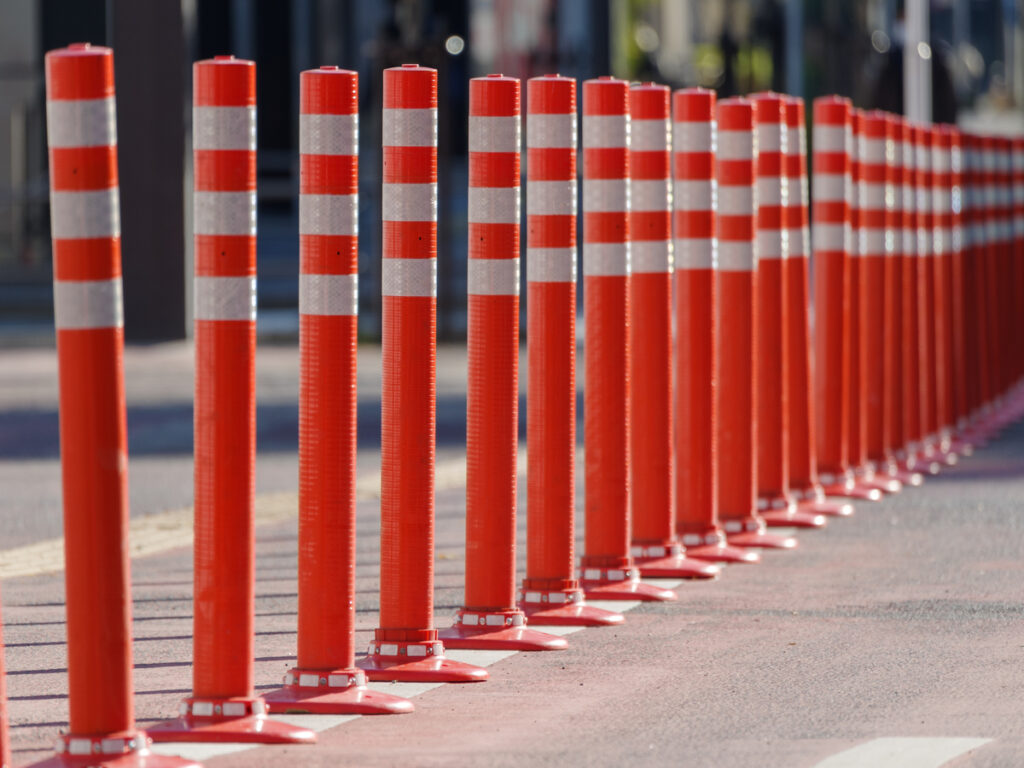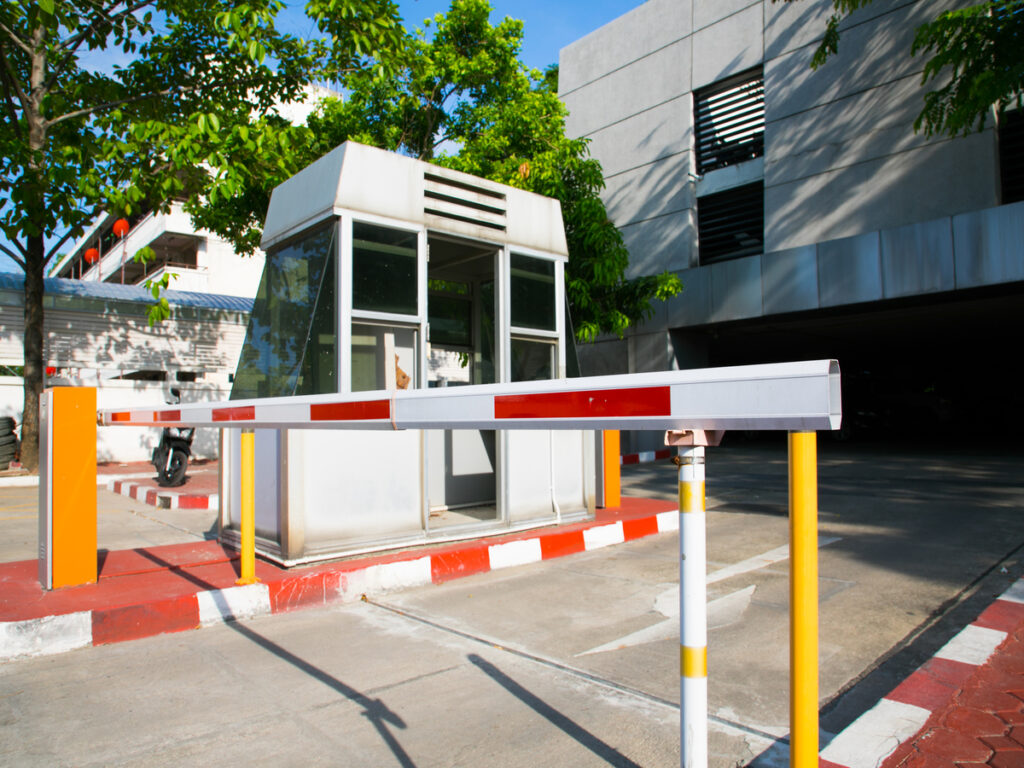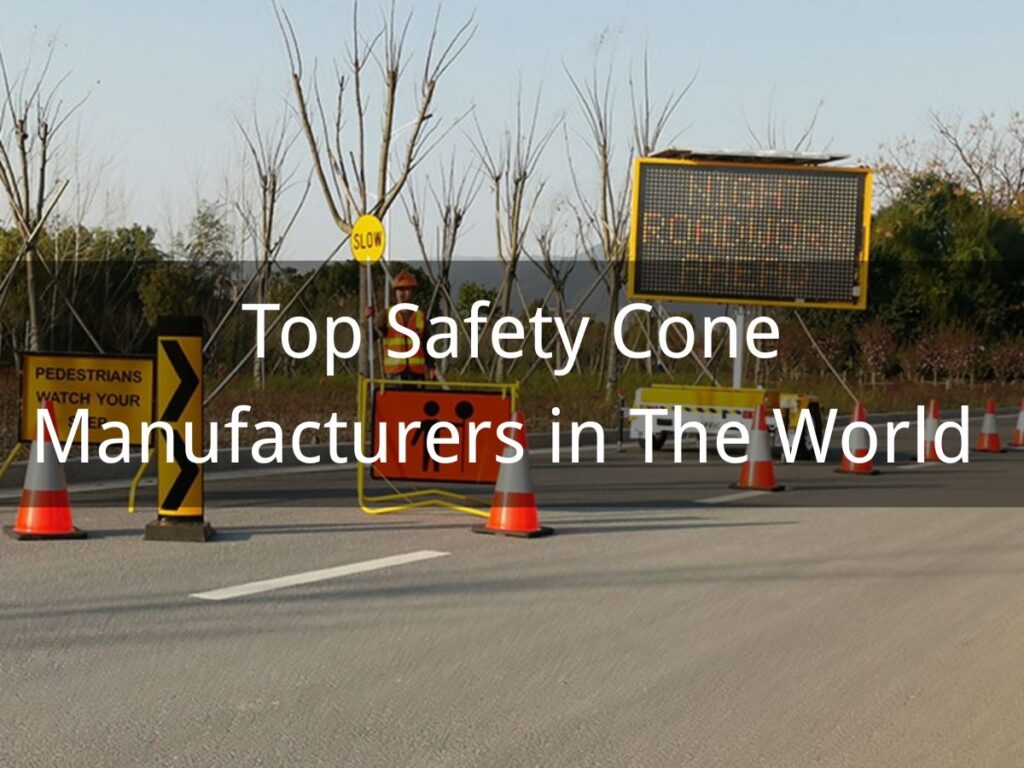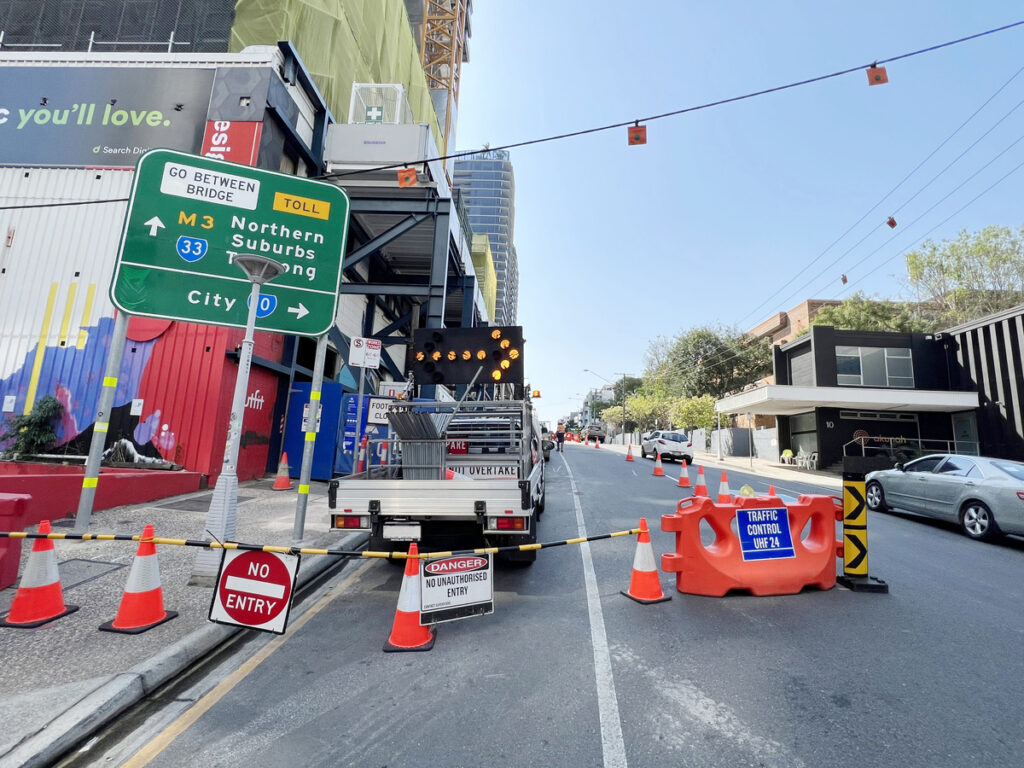
Immagina di dover tenere un negozio impegnato in sicurezza, but you pick the wrong bollard. A car could crash through, causing damage and danger. Ogni giorno, Di 60 vehicles hit commercial buildings, E 46% of these incidents happen at stores.
Quando guardi dissuasori stradali in vendita, ask the right questions. Use this checklist to make your investment safe and smart.
Takeaway chiave
- Choose bollards based on your site’s needs, like safety, controllo del traffico, e accessibilità.
- Pick the right material—steel for strength, stainless steel for durability, plastic for low cost.
- Consider installation costs and hire professionals for complex or fixed bollards.
- Maintain bollards regularly by cleaning, inspecting, and preventing rust to extend their life.
- Use certified, crash-rated bollards in high-risk areas to ensure real impact protection.
1. What Are Traffic Bollards and How Do They Work?
Definition of Bollards
You might see traffic bollards every day and not even notice them. Bollards are sturdy posts placed in the ground to block or guide vehicles. They come in many shapes and sizes, but their main job is to keep people and property safe. When you look at traffic bollards for sale, you’ll find options made from steel, calcestruzzo, or even plastic. Some look simple, while others have a modern design that fits right into city landscapes.
Bollards have changed a lot over the years. They started as simple posts but now include smart features, sensori, and even retractable designs for busy areas.
Purpose of Bollards: Controllo del traffico, Sicurezza pedonale, Sicurezza
Bollards do more than just sit on the sidewalk. Aiutano a controllare il traffico, proteggere i pedoni, and keep buildings safe from accidents. Cities use them to guide cars and bikes, making sure everyone follows the right path. In luoghi affollati, bollards stop vehicles from driving where they shouldn’t, which helps prevent injuries and saves lives. Ogni anno, vehicle crashes into buildings cause thousands of injuries and deaths. Bollards can stop these accidents before they happen.
- Bollards protect storefronts, scuole, and parks by absorbing the force of a crash.
- They help manage parking and keep cars out of pedestrian zones.
- Many cities use smart bollards to improve traffic flow and reduce pollution.
Tipi di dissuasori: Fisso, Rimovibile, Flessibile
You have several choices when picking traffic bollards for sale for your project. Here’s a quick look at the main types:
| Tipo | Descrizione | Migliori casi d'uso |
|---|---|---|
| Fisso | Permanently installed, molto forte, always in place | Negozi, edifici governativi |
| Rimovibile | Can be taken out or moved when needed, often with locking systems | Event spaces, emergency access areas |
| Flessibile | Piegati sull'impatto, return to shape, often made from plastic or rubber | Parcheggi, piste ciclabili, low-impact zones |
Fixed bollards offer the most protection. Removable bollards give you flexibility for events or deliveries. Flexible bollards work well where you want to guide traffic but don’t need heavy-duty barriers.
Mancia: When you shop for traffic bollards for sale, think about your site’s needs. The right type makes a big difference in safety and convenience.
2. What Is the Best Material for Bollards?

Choosing the right material for your bollards can make a big difference in safety, sguardo, and long-term costs. When you look at traffic bollards for sale, you’ll see options made from steel, plastica, acciaio inossidabile, and even iron. Each material has its own strengths and best uses.
Basta di acciaio: Durabilità & Forza
Steel bollards stand out for their toughness. You can count on them to handle heavy impacts and protect buildings from vehicles. They work well in places where you need strong barriers, like storefronts or parking lots. But steel needs regular care. If you skip repainting or anti-rust treatments, steel can rust and lose strength over time. You might find yourself replacing them more often after big impacts.
Plastic Bollards: Cost-Effective and Lightweight
Plastic bollards give you a budget-friendly choice. Sono leggeri, facile da spostare, and simple to install. You might use them for temporary events or to guide traffic in low-risk areas. Plastic bollards don’t need much cleaning or repainting. Tuttavia, they can bend or fade if cars hit them or if they sit in the sun for too long. They work best where you don’t expect strong impacts.
Basta di acciaio inossidabile: Corrosion Resistance for Harsh Environments
If you want something that lasts and looks good, I paletti in acciaio inossidabile sono una scelta intelligente. Resistono alla ruggine, anche in luoghi bagnati o salati. You won’t need to repaint them, and they keep their shine for years. Stainless steel bollards also come with modern finishes and can include features like sensors. Mentre all'inizio costano di più, you save money in the long run because you won’t need as many repairs or replacements.
Mancia: Stainless steel bollards are a great investment for busy city streets or high-security spots. They offer both style and strength.
Ferro duttile vs. Basta di ghisa: Best for Impact Resistance?
Iron bollards come in two main types: ductile and cast iron. Ductile iron bends under pressure, so it can handle impacts better without breaking. Cast iron is strong but can crack if hit hard. If you need bollards for places with lots of traffic or risk of crashes, ductile iron gives you better protection.
Here’s a quick table to help you compare some common bollard materials:
| Tipo di bollard | Costo iniziale | Esigenze di manutenzione | Durabilità | Frequenza di sostituzione | Costo-efficacia |
|---|---|---|---|---|---|
| Acciaio | Basso | Alto (needs repainting, anti-rust) | Moderare (può arrugginire) | Frequent after impacts | Lower long-term |
| Plastica | Basso | Basso (minimal cleaning) | Basso (curve, svanisce) | Più frequente | Buono per a breve termine |
| Acciaio inossidabile | Alto | Molto basso (no repainting needed) | Alto (resiste alla ruggine) | Raro | High long-term savings |
When you shop for traffic bollards for sale, think about your site’s needs and how much time you want to spend on upkeep. The right material helps you save money and keeps your property safe.
3. How Much Does Bollard Installation Cost?
Factors Influencing Installation Costs (Materiale, Site, Lavoro)
When you start looking at bollard installation, you’ll notice that prices can change a lot. The type of bollard you pick, the number you need, and where you plan to install them all play a big part in the final cost. Here’s a quick look at what can affect your budget:
| Fattore di costo | Spiegazione |
|---|---|
| Type of Bollards | Fixed bollards need permanent installation, which usually costs more. Shallow foundation bollards are easier and cheaper to install. Retractable bollards can be manual or automatic, and the more complex the system, the higher the price. |
| Quantità | More bollards mean higher total costs. Bulk orders can sometimes lower the price per unit, but installation adds up. |
| Posizione | Urban areas with lots of traffic often have higher labor costs. If your site is tricky to access, expect to pay more. |
| Optional Features | Extras like decorative covers, sensori, or automation will increase your installation bill. |
You should also think about the site itself. Rocky ground, old pavement, or underground utilities can make installation harder and more expensive.
Cost Breakdown for Different Types of Bollards
Not all bollards cost the same to install. Here’s a simple breakdown to help you compare:
- Basta di bollari fissi: Usually cost between $200 E $600 each for installation. These need digging and concrete, so labor is a big part of the price.
- Bish rimovibili: These cost a bit less to install because they don’t need as much digging. Expect to pay around $150 A $400 ogni.
- Retractable or Automatic Bollards: These are the most expensive. Manual retractable bollards start at about $500 ogni, while automatic ones can go over $2,000 ogni, depending on the system.
Mancia: When you see traffic bollards for sale, remember that the listed price often doesn’t include installation.
DIY vs Professional Installation: What’s the Difference in Cost?
You might wonder if you can save money by installing bollards yourself. DIY installation can cut labor costs, especially for simple plastic or lightweight bollards. But for fixed or automatic bollards, you need special tools and skills. Mistakes can lead to extra repairs or even safety risks.
Professional installers know how to handle tough sites and make sure everything meets safety codes. You pay more upfront, but you get peace of mind and a job done right. For most projects, especially in busy or high-risk areas, hiring a pro is the smart choice.
4. How Long Do Bollards Last?
Durability Based on Material Type
The lifespan of a safety bollard depends heavily on the material you choose. Steel bollards are known for their strength and durability, making them ideal for high-impact areas. Tuttavia, they can rust if exposed to moisture without proper care. Basta di acciaio inossidabile, d'altra parte, resist corrosion and maintain their appearance even in harsh environments like coastal areas. Plastic bollards are lightweight and cost-effective but may fade or weaken over time, especially in areas with heavy sun exposure or frequent impacts.
Mancia: If you’re installing safety bollards in a high-traffic or outdoor area, consider materials like stainless steel for long-lasting performance.
How to Extend the Lifespan of Bollards Through Maintenance
Regular maintenance can significantly increase the lifespan of your bollards. Here are some simple steps you can take:
- Clean bollards regularly to remove dirt and debris that can cause damage.
- Lubricate moving parts, especially for retractable bollards, to keep them operating smoothly.
- Inspect bollards monthly for cracks, ruggine, o indossare. Early detection prevents bigger problems.
- Apply anti-corrosion coatings to protect against rust in wet or salty environments.
- Address rust immediately with rust removers and protective coatings to stop further deterioration.
- Schedule professional maintenance for complex repairs and expert inspections.
Seguendo questi passaggi, you’ll not only keep your bollards looking great but also ensure they function properly for years to come.
Expected Lifespan of Steel, Plastica, and Stainless Steel Bollards
Different materials offer different lifespans. Basta di acciaio, when properly maintained, can last 20 anni o più. Senza cure regolari, rust and impacts may shorten their lifespan. Stainless steel bollards often outlast other materials, with some lasting over 25 years due to their corrosion resistance. Plastic bollards, while affordable, typically last 5 A 10 years depending on their exposure to sunlight and impact levels.
| Materiale | Durata media | Esigenze di manutenzione |
|---|---|---|
| Acciaio | 15–20 anni | Alto (anti-rust care) |
| Acciaio inossidabile | 20–25+ years | Basso (minimal upkeep) |
| Plastica | 5–10 anni | Basso (cleaning only) |
Nota: Investing in high-quality materials and routine maintenance can save you money in the long run by reducing replacement costs.
5. Are Bollards Resistant to Impact?

Bollard Crash Ratings: What Does It Mean?
When you look at traffic bollards, you want to know if they can really stop a car or truck. That’s where crash ratings come in. These ratings indicate the maximum force a bollard can withstand before allowing a vehicle through. Crash ratings depend on three things: the weight of the vehicle, how fast it’s going, and how far it moves past the bollard after hitting it.
Here’s a quick look at some crash test results:
| Test Description | Vehicle Weight (libbre) | Velocità (mph) | Penetration Distance (pollici) |
|---|---|---|---|
| Independent ASTM Test | 2,430 | 42.6 | < 24 |
| Engineered Rating (designed stopping power) | 5,000 | 30 | < 12 |
You might also see K-ratings and M-ratings. Per esempio, a K12: L3 rating means a 15,000-pound truck hit the bollard at 50 mph and only moved less than 3 feet past it. That’s strong protection!
Crash ratings help you match the right bollard to the risk at your site. Always check these numbers before you buy.
Standards for Crash-Rated Bollards (ASTM, NON, IWA)
Crash-rated bollards must meet strict standards. These standards make sure the bollards work as promised. Negli Stati Uniti, ASTM F2656 and F3016 are the main standards. They replaced older K-ratings. ASTM M-ratings (like M30, M40, M50) show how fast and heavy a vehicle can be for the bollard to stop it.
Nel Regno Unito, NON 68 is the standard. It tests bollards with real vehicles, measuring speed, peso, and how far the vehicle goes after impact. IWA 14-1 is the global standard. It checks the same things, so you know the bollard will work anywhere in the world.
| Standard | Cosa misura | Example Rating |
|---|---|---|
| ASTM F2656 | Vehicle type, velocità, penetration | M50 P1 (50 mph, ≤3.3 ft) |
| NON 68 | Vehicle mass, velocità, angolo, penetration | V/7500[N2]/80/90:0.0 |
| IWA 14-1 | Global vehicle impact performance | V/7200[N2A]/64/90:2.5 |
How Bollards Are Tested for Impact Resistance
You might wonder how experts test these traffic bollards for sale. They use real vehicles and crash them into the bollards at set speeds. They measure how far the vehicle moves past the bollard. If the bollard stops the vehicle with little or no movement, it passes the test.
Crash tests use different vehicles, like small cars or big trucks. The tests check if the bollard can handle the worst-case scenario. Certified labs run these tests to make sure the results are fair and accurate.
- Real vehicles hit the bollard at high speeds.
- Experts measure the distance the vehicle travels after impact.
- Only bollards that meet strict standards get certified.
If you need impact-resistant bollards, always look for ones that have passed these tough tests. Da questa parte, you know your property and people stay safe.
6. Can Bollards Be Removed or Adjusted?
Bish rimovibili: Caratteristiche e vantaggi
You might need to let vehicles through sometimes, but still want strong protection most of the time. Removable bollards give you that flexibility. You can unlock and lift them out when you need access, then put them back in place for safety. These bollards work well in parking lots, aree pedonali, or places where you need to control access only during certain hours.
Removable bollards stand out because they adapt to your needs. Market research shows that these designs help you manage traffic in busy environments. You get a cost-effective solution that doesn’t lock you into one setup. Many cities now use smart removable bollards with sensors or remote controls, making it even easier to manage who comes and goes.
- You can remove them quickly for emergency vehicles or maintenance.
- They protect important spots like water valves or electrical boxes.
- You save money by only using barriers when you need them.
- Smart features like RFID or biometric scanners add extra security and convenience.
Mancia: Place removable bollards at the right height and spacing for the best mix of safety and access.
Temporary Bollards for Events or Short-Term Projects
Sometimes you need barriers just for a day or two. Temporary bollards are perfect for special events, costruzione, o emergenze. You can set them up fast and move them when the event ends.
- At big sporting events like the FIFA World Cup, portable barriers kept fans safe.
- Music festivals and city parades use temporary bollards to guide crowds and block vehicles.
- Cities like New York rely on portable barriers where permanent ones won’t work.
- Quick deployment helps protect VIPs at political events or parades.
Recent events show why temporary bollards matter. Durante il 2025 Rose Parade, mobile barriers kept people safe without blocking the fun. In Austin, portable bollards made public events safer for everyone.
Locking Mechanisms for Removable Bollards
You want to make sure only the right people can remove your bollards. That’s where locking mechanisms come in. Most removable bollards use strong locks—like padlocks, internal locks, or even electronic systems. Some advanced models use smart tech, letting you unlock them with a key card or phone app.
A good lock keeps your site secure when the bollard is in place. It also makes removal quick and easy when you need access. Always check that your locking system matches your security needs and is easy for your team to use.
Nota: Regularly check and maintain your locks to keep your removable bollards working smoothly and safely.
7. How Do I Choose the Right Bollard for My Site?
Considerations Based on Site Location and Usage
Choosing traffic bollards for sale starts with looking at your site. Is it a busy city street, a quiet parking lot, or a school entrance? Each place has its own needs. You want to think about what happens there every day. Per esempio, a government building or airport needs strong barriers because of higher security risks. A shopping center may need bollards to guide cars and protect people walking by.
Here’s a table to help you match your site’s needs with the right bollard features:
| Fattore | Dettagli & Insights |
|---|---|
| Security Drivers | High-risk sites need strong barriers to stop vehicles. |
| Gestione del traffico | Use bollards to guide cars, Mark Lanes, and keep people safe in busy areas. |
| Material Types | Steel works best for security. Concrete is good for permanent spots. Plastic fits low-impact uses. |
| Installation Types | Surface-mounted bollards are easy to move. In-ground bollards stay put and offer more protection. |
| Aree di applicazione | Think about security, flusso del traffico, e sicurezza pedonale. |
| Emerging Trends | Smart bollards with sensors and automation are becoming popular. |
Fattori da considerare: Flusso di traffico, Traffico pedonale, Sicurezza
You need to look at how cars and people move around your site. Heavy traffic means you need stronger, more visible road bollards. If lots of people walk by, you want bollards that keep them safe but don’t block the path. Security is also key. Some places need bollards that can stop a car crash, while others just need to mark a boundary.
Here are some steps to help you decide:
- Check the ground and look for things like underground pipes or cables.
- Watch how cars and people move during busy times.
- Pick a spot where road bollards will do the most good without getting in the way.
- Make sure you follow the rules for how deep and strong the bollards need to be.
- Test any moving or removable bollards to see if they work well.
- Plan to check and clean your bollards often, especially after storms or accidents.
Mancia: Always use a professional installer for permanent bollards. This keeps your site safe and up to code.
Bollard Options for High-Traffic Areas vs Low-Traffic Areas
Not every site needs the same kind of bollard. Aree ad alto traffico, like city centers or stadiums, need strong, fixed bollards made from steel or concrete. These can handle lots of bumps and keep people safe. In places with less traffic, like small parks or private driveways, you can use lighter, rimovibile, or even plastic bollards.
If you want to see what’s available, check out traffic bollards for sale that match your site’s needs. You’ll find options for every situation, from heavy-duty barriers to simple guides for cars and bikes.
Nota: Smart road bollards with sensors are great for places that need both safety and flexibility. They can open for emergency vehicles or close off streets during events.
8. Are Bollards Compliant with ADA and Other Regulations?
ADA Compliance for Bollards and Pedestrian Pathways
You want everyone to move safely and easily around your site. ADA compliance makes sure people with disabilities can get through walkways without trouble. When you install traffic bollards, you need to think about how far apart they are. If you space bollards too close, someone in a wheelchair might not fit. If you space them too far, cars might sneak through.
Ecco cosa devi sapere:
- Bollards should be at least 3 piedi di distanza. This gives enough room for wheelchairs and walkers.
- Spacing should not go over 5 piedi. This keeps vehicles out but lets people pass.
- These rules help keep pathways open and safe for everyone.
Mancia: Always measure the space between bollards before you finish the job. This small step makes a big difference for accessibility.
MUTCD Guidelines for Bollard Placement and Spacing
Il manuale sui dispositivi di controllo del traffico uniforme (MUTCD) sets the rules for where and how you place bollards. You want drivers and pedestrians to see bollards clearly, anche di notte. MUTCD says traffic bollards for sale in low-speed zones should stand at least 18 pollici di altezza. In aree ad alta velocità, they need to be at least 28 pollici. Reflective bands help people spot them in low light.
You also need to follow spacing rules. Proper spacing keeps traffic moving safely and protects workers or pedestrians. MUTCD guidelines make sure bollards guide cars the right way and stop them from going where they shouldn’t.
| Zone Type | Altezza minima | Bande riflettenti | Scopo |
|---|---|---|---|
| Low-Speed | 18 pollici | SÌ | Traffico guida, segnalare i pericoli |
| High-Speed | 28 pollici | SÌ | Boost visibility, sicurezza |
OSHA Regulations for Bollards in Construction Zones
If you work near construction, you know safety comes first. Regole OSHA say you must use bollards and cones that meet certain standards. Workers need training on how to set up and use these barriers. You should check bollards often to make sure they stay the right height and have bright, bande riflettenti.
- Train workers on correct placement and use.
- Inspect bollards regularly for damage or fading.
- Use trusted products that meet OSHA and MUTCD standards.
- Make sure reflective bands are clean and visible, soprattutto di notte.
Following these rules helps you avoid accidents and keeps your site safe for everyone.
9. What Are the Maintenance Requirements for Bollards?
Regular Inspections and Cleaning
You want your bollards to keep working and looking good. Ispezioni regolari ti aiutano a individuare i problemi in anticipo. Walk around your site and check each bollard for dents, crepe, or signs of rust. Se vedi danni, correggilo subito. This simple habit keeps your property safe and your bollards strong.
Cleaning is just as important. Sporco, polvere, and grime can build up fast, Soprattutto nelle aree trafficate. Use a soft brush or cloth with mild soap and water. Wipe down the bollards to keep them visible and bright. Clean bollards are easier for drivers and pedestrians to see, che aiuta a prevenire incidenti.
Routine inspections and cleaning help you catch small issues before they turn into big problems. This keeps your bollards working well and looking sharp.
How to Prevent Corrosion on Steel Bollards
Steel bollards are tough, but they can rust if you don’t take care of them. You can stop corrosion by using anti-rust paint or coatings. Make sure you cover every part of the bollard, especially near the ground where water collects. If you spot any rust, scrub it off and repaint the area right away.
Here are some tips to keep steel bollards in top shape:
- Apply anti-corrosion coatings every year.
- Check for scratches or chips in the paint.
- Fix damaged spots quickly to stop rust from spreading.
Regular care helps your steel bollards last longer and keeps them looking new.
Replacing Reflective Tape on Plastic and Steel Bollards
Reflective tape makes traffic bollards for sale stand out at night or in bad weather. Col tempo, the tape can fade, buccia, or get dirty. You should check the tape during your regular inspections. If it looks worn out, Sostituilo subito.
Segui questi passaggi:
- Peel off the old tape.
- Clean the surface with rubbing alcohol.
- Stick on new reflective tape, pressing firmly.
Fresh tape keeps your bollards visible and your site safe. Keeping up with these small tasks means your bollards will always do their job—protecting people and property.
10. How Do I Know If I Need Certified Bollards for My Project?
Understanding the Need for Certified Bollards in High-Risk Areas
You might wonder if your site really needs certified bollards. If you manage a place with lots of vehicle traffic or a risk of crashes, certified bollards are a must. These traffic bollards for sale go through tough tests at special labs. They earn ratings like K or M, which show they can stop or slow down cars and trucks after a crash. Per esempio, a bollard with an M50/P1 rating can stop a heavy truck moving fast, with the vehicle barely getting past the barrier. This level of protection is key for places like airports, edifici governativi, or busy storefronts. Certified bollards meet strict standards such as ASTM F2656, NON 68, e IWA 14-1. These standards prove the bollards can handle real-world impacts and keep people safe.
Impact Protection vs. Aesthetic Function
Not every project needs the same kind of bollard. Some bollards look nice and help guide people or mark boundaries. Others must stop vehicles and protect lives. If you only want to add style or mark a path, you can use decorative or non-certified bollards. But if you need to block vehicles or protect against crashes, certificato, crash-rated bollards are the right choice. Certified models offer real impact protection, not just good looks.
Ecco un rapido confronto:
| Caratteristica | Certified Steel Bollards | Non-Certified Concrete Bollards |
|---|---|---|
| Resistenza all'ambiente | Alto, crash-test rated | Basso, may crack or break |
| Livello di sicurezza | Stops fast, heavy vehicles | Basic access control only |
| Flessibilità | Rimovibile, retractable options | Permanente, no flexibility |
| Costo | Più alto in anticipo, better value | Inferiore in anticipo, more replacements |
When to Choose Certified Bollards (Crash-Rated, OSHA, Ada)
You should pick certified traffic bollards for sale when your site faces real risks from vehicles. Choose crash-rated bollards for high-security areas, strade trafficate, or places where accidents could cause big damage. If you work in construction or public spaces, OSHA and ADA rules may require certain types of bollards for safety and accessibility. Certified bollards also help you meet these rules and avoid fines. When you want both safety and peace of mind, certified options are the best investment.
Mancia: If you’re not sure what your site needs, talk to a bollard expert. They can help you match the right certification to your project’s risks and goals.
Conclusion — How to Make the Best Decision for Your Project
Takeaway chiave: Understanding Your Site’s Needs
Choosing the right traffic bollard starts with knowing what your site needs. You want to keep people safe, control cars, and make sure everyone can get where they need to go. Here’s a simple framework you can follow:
- Decide what you want your bollards to do—stop cars, Guida le persone, or both.
- Look at how many cars and people move through your area each day.
- Make sure your bollards don’t block people with wheelchairs or strollers.
- Plan for emergencies by using removable or automatic bollards.
- Pick materials that last and meet crash standards.
- Check that your bollards are easy to see, anche di notte.
- Keep up with regular cleaning and repairs.
Ricordare: The best bollard is the one that fits your site’s unique needs and keeps everyone safe.
How to Get Expert Help with Your Bollard Selection
You don’t have to figure this out alone. Experts can help you choose the right bollard for your project. They look at things like crash ratings, material strength, and how deep the foundation should go. Here’s a quick table to show what experts consider:
| Fattore | What Experts Recommend |
|---|---|
| Crash Ratings | Use M30 or M50 for high-risk areas |
| Selezione del materiale | Acciaio, calcestruzzo, or stainless steel for durability |
| Profondità della fondazione | Deep mount for strong protection, shallow for quick install |
| Tipo di bollard | Fisso, rimovibile, or automatic based on your needs |
| Manutenzione | Regular checks and cleaning |
| Conformità | Follow all safety and accessibility rules |
Talking to a pro saves you time and helps you avoid costly mistakes.
Request a Quote: Reach Out for Custom Bollard Solutions
Ready to take the next step? Reach out to a trusted traffic safety products supplier for a custom quote. Share your site details, flusso del traffico, e obiettivi di sicurezza. Many companies offer traffic bollards for sale that fit your exact needs. You’ll get advice on the best options, Prezzi, e installazione. Da questa parte, you make a smart investment that protects your property and everyone who visits.
If you’re still unsure, why not hear what our customers have to say? Guardare OPTRAFFIC’s customer testimonial videos on LinkedIn to see how we’ve delivered professional, reliable traffic safety products for a variety of projects, helping you choose with confidence and buy with peace of mind.
Domande frequenti
What is the difference between a bollard and a barrier?
A bollard is a short post that guides or blocks vehicles. UN traffic barrier is usually bigger and covers more space. You use bollards for access control or safety. Barriers often block whole roads or parking lots.
Can I paint my bollards any color?
SÌ, you can paint your bollards. Bright colors like yellow or red help drivers see them. Some places have rules about colors, so check local guidelines first.
How do I know how many traffic bollards for sale I need?
Count the spaces you want to protect. Measure the width of each area. Place bollards about 3 A 5 piedi di distanza. This keeps cars out but lets people walk through.
Are bollards safe for bikes and wheelchairs?
SÌ, if you space them right. Leave at least 3 feet between each bollard. This gives bikes and wheelchairs enough room to pass safely.
Do bollards need electricity to work?
Most bollards do not need electricity. Only automatic or smart bollards use power. Fixed and removable types work without any wiring.



















